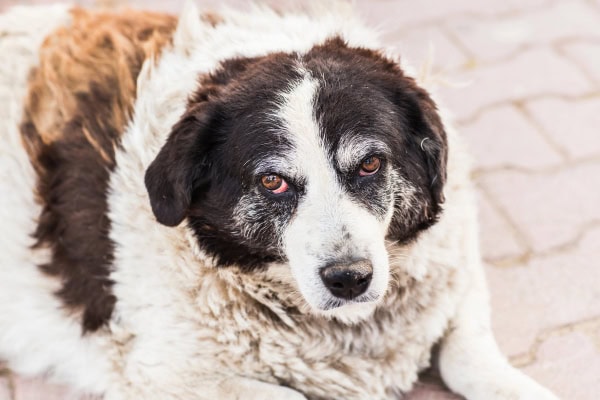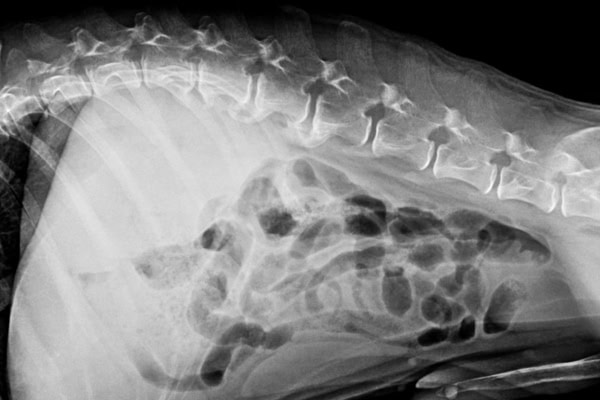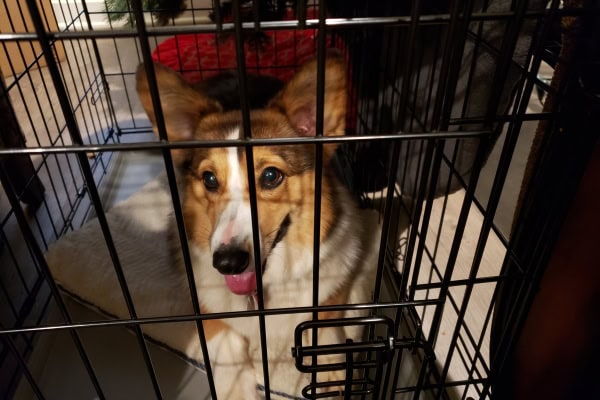Discospondylitis in dogs is a painful bacterial or fungal infection of the intervertebral discs and vertebrae of a dog’s spinal column. Integrative veterinarian Dr. Julie Buzby explains the causes, symptoms, diagnosis, treatment, and prognosis for discospondylitis in dogs.

Recently, my client brought his Hound mix, Rooster, to see me for persistent and worsening back pain. A few months before, Rooster had come into the vet hospital because he had been severely attacked by a coyote. At that time, he had a deep wound along his back that I surgically repaired.
However, while the wound appeared to have healed well, Rooster’s back continued to be painful. And it seemed to be getting worse. He looked miserable standing all hunched up in my office that day and was clearly very painful. I recommended an X-ray to examine his back, which revealed that Rooster was suffering from discospondylitis (also spelled diskospondylitis).
What is discospondylitis in dogs?
Discospondylitis in dogs is a bacterial or fungal infection of the spine. More specifically, it is an infection of the intervertebral disc space (i.e. place where the jelly-like intervertebral discs live) and the adjacent vertebral bodies. It may occur in one spot or multiple locations along the spine.
What are the symptoms of discospondylitis in dogs?
When a dog develops discospondylitis, the symptoms may vary depending on how severe the dog’s infection is, the location of the infection in the spine, and if multiple areas of the spine are affected. But some of the most common clinical signs include:
- Spinal pain and sensitivity when the back is touched—The dog may yelp, try to bite, or run away when you pet his or her back.
- Arching of the back—Rather than standing with flat back, a dog with discospondylitis may have a curved back due to pain.
- Abnormal gait—The dog may take shorter strides or appear to be walking stiffly.
- Weight loss—Over time, discospondylitis can cause a dog to lose weight unexpectedly.
- Decreased appetite—Affected dogs may not feel much like eating.
- Appearing depressed or like a lethargic dog—Your dog may just want to lay around rather than getting up and participating in activities.
- Reluctance to move or walk—Due to the pain, your dog may prefer to stay in one place.
- Fever—The dog may develop a fever as the body tries to fight the infection.
- Decreased activity—Affected dogs may no longer be running, jumping, playing, or wanting to go on walks.
- Appearing painful when turning a specific way—Your dog may wince, freeze, or cry out when performing a certain movement.
In general, the signs of discospondylitis begin gradually and may even mimic other diseases. But the symptoms progress over time and become severe. As the disease worsens or spreads, dogs can become increasingly stiff and develop muscle weakness (especially in the legs). And in severe cases of discospondylitis, dogs may even become paralyzed.
So, why does this happen?

What causes discospondylitis in dogs?
As mentioned, discospondylitis occurs when bacteria or fungi enter the intervertebral discs. There are three main ways that this can happen:
1. Hematogenous spread
Hematogenous spread (i.e. blood-borne spread) occurs when a dog has a wound or infection that allows bacteria or fungi to enter the bloodstream. Since blood circulates throughout a dog’s whole body, the bacteria or fungi can spread to the intervertebral disc space via the blood—therefore causing an infection. This is the most common way that dogs develop discospondylitis.
2. Migrating foreign body
A foreign body is an object like a grass awn or foxtail in dogs that should not normally be in the body. It may originally enter a dog’s body through the mouth, ear, nose, or a wound (like on the paw). But, if it goes unnoticed, it can migrate toward the spinal cord. This can cause irritation and inflammation. And if there is bacteria or fungus present on the foreign body, the dog may also develop discospondylitis.
3. Direct contamination
Discospondylitis due to direct contamination occurs when the bacteria or fungi are directly put into the affected disc. Most often this happens after a dog has a deep puncture wound or bite on the back where the spinal column is located. (This is what happened to poor Rooster after being attacked by the coyote.) Direct contamination can also occur during spinal surgeries.
Which dogs are at risk for discospondylitis?
Bacterial or fungal discospondylitis can develop in any dog. But, as you may guess from the list of causes, there are some predisposing factors that can put a dog at higher risk of developing discospondylitis.
Dogs who are in areas where grass awns are present
Dogs who live (or hike and play) in areas where grass awns and foxtails are prevalent have an increased chance of developing discospondylitis. It’s difficult to explain why these awns and seeds tend to migrate toward the spinal column if left untreated, but they do.
Dogs with bacterial infections
Additionally, dogs with certain bacterial infections are also predisposed to discospondylitis. Some of these infections include:
- Bacterial endocarditis (i.e. bacterial infection of the heart valves)
- Severe dental disease in dogs or infection at the site of a dog tooth extraction
- Urinary tract infections (UTIs in dogs)
- Chronic skin disease (including pyoderma in dogs and fungal skin infections)
- Prostate infections (a cause of an enlarged prostate in dogs)
- Brucellosis—A highly contagious infection with the bacterium brucella canis that usually develops in a dog’s reproductive system. It also has zoonotic potential—which means it can spread to humans.
These infections can reach the spinal cord via the blood and lead to discospondylitis.
Dogs of a specific age or breed
In general, discospondylitis is most common in medium and large breed dogs who are middle-aged. However, the disease can develop in small breed dogs or dogs of any age. Some predisposed dog breed include:
- German Shepherd dogs
- Doberman Pinschers
- Great Danes
- Boxers
- Rottweilers
- English Bulldogs
- Rhodesian Ridgebacks
- Basset Hounds
Since there are certain breeds that are diagnosed with this disease more often, many people wonder, “Is discospondylitis in dogs hereditary?” However, the answer is, no, discospondylitis is not considered hereditary. Rather, there are some breeds who are more likely to develop certain diseases and problems that increase the risk of discospondylitis.
How is discospondylitis in dogs diagnosed?
Even given these predisposing factors, diagnosing discospondylitis in dogs can be difficult. It may take a variety of tests to confirm if your dog has the disease or not. And you may not get clear answers right away.
If, based on the symptoms and your dog’s past history, your vet suspects your dog has discospondylitis, he or she will start by performing a physical exam. This involves your vet carefully looking your dog over from nose to tail for any abnormalities, changes, or signs of pain.
Then, depending on the exam findings, the veterinarian may recommend some diagnostic testing to rule out other possible diseases and to confirm discospondylitis. Some of these potential tests include:
Blood work
Blood tests for dogs may show an elevated white blood cell count in dogs with discospondylitis due to the infection. Plus, blood work can also help rule out other reasons that your dog might be painful, not eating, or losing weight.
X-rays
You can only see the bones, not the actual discs on X-rays. But the vet may be able to see evidence of destruction of the edges of the bone on both sides of the disc space (i.e. vertebral end plates) and the vertebrae itself. This pattern of damage is classic for discospondylitis. However, these changes may not be visible on X-rays for 3-6 weeks after clinical signs appear. Therefore, your veterinarian may need to take X-rays a couple weeks apart to verify if there are changes present or not.

Additionally, X-rays can help rule out other problems such as osteoarthritis in dogs, fractures, cancer (e.g. osteosarcoma in dogs), IVDD in dogs, and more.
Neurologic exam
The neurologic exam is an extension of your veterinarian’s physical exam. Unfortunately, some dogs with discospondylitis will experience gradual and progressive neurological deficits like partial or complete paralysis.
Advanced imaging
If your veterinarian suspects your dog has discospondylitis based on an X-ray and other findings, he or she might recommend advanced imaging such as a CT or MRI at a specialty hospital. This can help better characterize the disease.
CSF collection and analysis
If your vet refers your dog to a veterinary specialist near you (such as a neurologist), the specialist may want to collect cerebral spinal fluid (CSF) for analysis. This allows the neurologist to assess the protein and white blood cell levels of the CSF and determine what sort of cells are present in the CSF. Plus, the neurologist might recommend culturing the CSF.
Disc cultures
The best way to determine what is causing the discospondylitis is to culture material from the infected disc space. Typically, obtaining a sample involves performing a fine needle aspirate (FNA) with CT or fluoroscopy guidance while the dog is anesthetized. However, this isn’t always feasible in all cases.
Blood or urine cultures
The vet may also want to perform blood cultures to try to determine which organism could be causing the discospondylitis and how best to treat it. However, sometimes the blood cultures won’t grown any organisms. Or the organism that grows isn’t actually the one causing the discospondylitis.
In addition to blood, disc, or CSF cultures, the vet may also recommend a urinalysis and urine culture. This is the case because many dogs with discospondylitis also have urinary tract infections that will need to be addressed.
What is the treatment for discospondylitis in dogs?
Once the vet diagnoses your dog with discospondylitis, he or she will formulate a treatment plan. Treatment varies depending on the cause of the disease, but it may include the following components:
Long-term use of antibiotics or antifungals
One of the most important parts of treatment is long-term use of antibiotic or antifungal medications. Your veterinarian will select the correct antibiotic or antifungal based on the disc, blood, CSF, and/or urine culture results.
In a study of 513 dogs with discospondylitis, the average length of treatment was 53.7 weeks. But practically speaking, you can expect your dog to need to take antibiotics or antifungals for 6-12 months, or potentially longer.
Treatment for the underlying cause
Additionally, your veterinarian will also try to address the underlying cause of the discospondylitis where applicable.
Pain medications
Since discospondylitis is generally very painful, your vet will prescribe pain medications for your dog. This may be non-steroidal anti-inflammatory drugs (NSAIDs) such as carprofen for dogs. Or the vet may also prescribe tramadol for dogs, gabapentin for dogs, amantadine for dogs, or other pain medications.
Cage rest or exercise restriction
The veterinarian may recommend crate rest for dogs who have more severe cases of discospondylitis. But with less severe cases, exercise restriction (e.g. short leash walks outside but no running or playing) for a period of time may be sufficient.

Mobility aids
If your dog has weakness or ongoing muscle loss, he or she may need assistance walking and moving around. Depending on the severity of your dog’s condition, there are different options you can try until his or her strength returns.
One of my recommendations for dogs with discospondylitis is Dr. Buzby’s ToeGrips® dog nail grips. These non-slip rings fit on a dog’s nails to provide traction. ToeGrips are a great short-term solution for dogs with discospondylitis because they can help a weak dog stand up and walk without slipping on the smooth floor.
Additionally, if your dog has partial or complete paralysis, you may need to use a sling to help him or her move around. One of my favorite options is the Help ‘Em Up® Mobility Harness. This wearable harness provides full-body support, which makes it great for a dog who needs more help standing up and moving. Alternatively, if your dog just needs some intermittent hind-end support, the GingerLead® Support and Rehabilitation Harness can be another great option.
Rehabilitation therapy
Some dogs may also benefit from rehabilitation therapy with a rehabilitation practitioner. This can be a great way to strengthen weak muscles, maintain range of motion in joints, and relieve pain.
Appetite stimulants
If a dog is not eating well, the vet may recommend appetite stimulants for dogs.
How will the vet monitor a dog with discospondylitis?
Typically, clinical signs may begin to improve within 1-2 weeks of starting treatment. But the dog will still require ongoing therapy and routine check-ups with the veterinarian. During treatment, your veterinarian will likely perform X-rays every 4-6 weeks to monitor your dog’s response to therapy. And he or she might also recommend periodic blood tests or other diagnostics as well.
If your dog fails to respond to treatment, your veterinarian may refer your dog to a specialist for surgery. During the procedure, the specialist can explore the affected area, flush out any debris or foreign bodies, and take steps to reduce pressure in the spinal cord. Plus, surgery also gives the vet a chance to collect samples of the affected area for culture. Based on the culture results, the vet can determine if your dog needs a different antibiotic or antifungal.
What is the prognosis for dogs with discospondylitis?
Depending on the underlying cause, the severity of the damage to the vertebral column, and the dog’s response to treatment, the prognosis for dogs with discospondylitis can vary from good to guarded.

Bacterial discospondylitis
Bacterial discospondylitis in dogs usually has a good prognosis. And it can often be cured with 6-12 months of antibiotic treatment (with the exception of brucellosis, which may require life-long antibiotic therapy). Overall, the prognosis improves if the disease is caught early and if the treatment is aggressive.
However, it is important to note that relapses can occur. And the dog may need more diagnostics or additional (and different) antibiotics. Plus, if an ongoing health condition caused the discospondylitis, the dog may need long-term treatment for that problem as well to prevent reoccurrence of discospondylitis.
Fungal discospondylitis
On the other hand, fungal discospondylitis is not as easy to cure as the bacterial version. Not all dogs respond to the treatment with antifungal medications. Therefore, this form has a guarded to fair prognosis. Plus, even the dogs who do respond to the antifungals often need the medication for the rest of their lives. Life-long use of antifungals can help prevent the infection from spreading or becoming worse and minimize the symptoms associated with the disease.
Dogs with paralysis
Sadly, if your dog had severe neurological deficits and is paralyzed, the prognosis decreases to guarded to poor.
Back to my patient
Remember Rooster, the dog you met at the beginning of the article? Well, thankfully due to knowing Rooster’s history of the coyote attack and looking at the timeline of his symptoms, I was able to diagnose him with discospondylitis early in the course of the disease.
I started Rooster on antibiotics and pain medication, applied ToeGrips, and recommended some physical therapy exercises. Over time, we began to see positive changes in Rooster’s symptoms—indicating the treatment was working. And after many months of antibiotics and a lot of X-rays, I’m happy to say that Rooster made a full recovery!
You can play a big part in helping your dog recover
Learning that your dog has discospondylitis and will require months of treatments and multiple rechecks with the vet can be more than a bit overwhelming. But you can do it. Each day, ensure you give your dog his or her medications on time and follow your vet’s other instructions. And if you feel like your dog isn’t improving or has taken a turn for the worse, reach out to your vet. That way he or she can make any necessary adjustments to the treatment plan.
By keeping up with your dog’s at-home care, coming back for scheduled rechecks, and reporting any concerns to your vet, you can give your dog the best chances possible to make a full recovery. Then, hopefully in time, discospondylitis can just be a distant memory for you and your dog.
Has your dog had discospondylitis?
Please share his or her story below.


My 8 1/2 year old German Shepard is going thru this now. At first we thought she was just getting older, not running around and not playing. She wasn’t showing any signs of being in pain though. The doctor did a X-ray and said she has arthritis. They gave us pain pills for her. Then one day she couldn’t stand up at all. Her back legs were paralyzed. We rushed her to the vet. They did X-rays and found out what was wrong with her and started her on medication. Pain pills and two different kinds of antibiotics. She just went back today, 6 months later and still taking the medication. The infection is still there but not as bad as it was. Her next appointment is in August. I’m praying she will be healed by then. She accepted taking the pills now and doesn’t fight me with that anymore atleast. Seeing her in pain and paralyzed was absolutely heartbreaking.
Dear Kelly,
I am sorry your Shepherd has been through so much over the last few months. I am glad she responded favorably to the medication, and you have seen improvement in her condition. Hoping her next recheck goes smoothly and you get the results you are wishing for. Bless you both and keep up the good work!